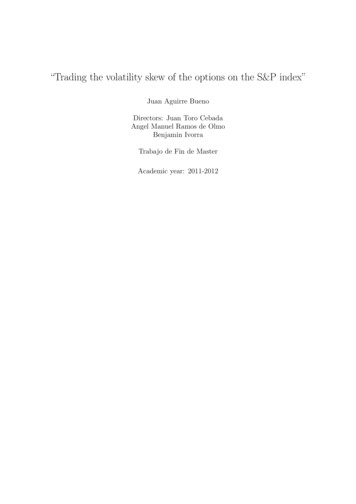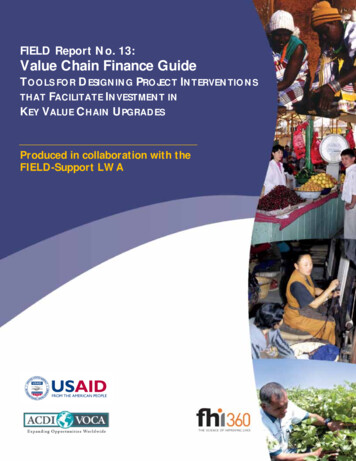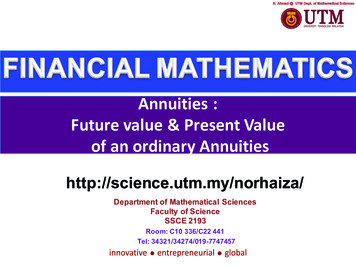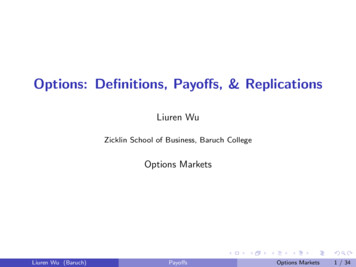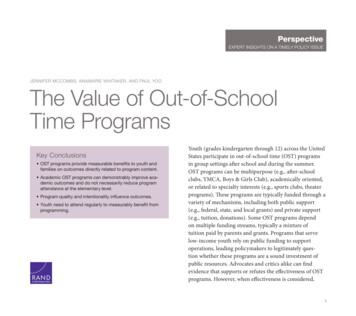
Transcription
PerspectiveEXPERT INSIGHTS ON A TIMELY POLICY ISSUEJENNIFER MCCOMBS, ANAMARIE WHITAKER, AND PAUL YOOThe Value of Out-of-SchoolTime ProgramsKey Conclusions OST programs provide measurable benefits to youth andfamilies on outcomes directly related to program content. OST programs can demonstrably improve aca Academicdemic outcomes and do not necessarily reduce programattendance at the elementary level. Program quality and intentionality influence outcomes. Youth need to attend regularly to measurably benefit fromprogramming.C O R P O R AT I O NYouth (grades kindergarten through 12) across the UnitedStates participate in out-of-school time (OST) programsin group settings after school and during the summer.OST programs can be multipurpose (e.g., after-schoolclubs, YMCA, Boys & Girls Club), academically oriented,or related to specialty interests (e.g., sports clubs, theaterprograms). These programs are typically funded through avariety of mechanisms, including both public support(e.g., federal, state, and local grants) and private support(e.g., tuition, donations). Some OST programs dependon multiple funding streams, typically a mixture oftuition paid by parents and grants. Programs that servelow-income youth rely on public funding to supportoperations, leading policymakers to legitimately question whether these programs are a sound investment ofpublic resources. Advocates and critics alike can findevidence that supports or refutes the effectiveness of OSTprograms. However, when effectiveness is considered,1
Recommendations When making funding decisions, federal and state policymakers should consider all benefits of programs. private funders, and intermediaries should Policymakers,incentivize and support out-of-school time providers’ efforts to develop intentional, high-quality programs. private funders, and researchers should bet Policymakers,ter catalog and assess the value and quality of experiencesoffered in OST programs. Funders should expect and researchers should measureoutcomes that align with program content. Programs should work to maximize attendance of eachindividual student.programs are often grouped together without regard fordifferences among program goals (e.g., improve academicperformance, promote positive social skills, or decreasesubstance use), content, or the measurable outcomes programming might produce.Recently, OST funding at the federal level has come underscrutiny. The President’s 2018 budget, while attempting toreduce the federal deficit, has proposed to eliminate the21st Century Community Learning Centers (CCLC) grant,which is one of the largest funding sources that can beused for OST programs (among other eligible activities).In addition, Child Care and Development Block Grants—the other major federal funding source for OSTs—wouldbe held at fiscal 2016 spending levels. The result wouldbe a dramatic reduction in federal funding that could beused for OST programs. Proponents of the proposed cutto 21st CCLC funding cite program ineffectiveness inincreasing academic performance. However, this position2is largely based on one evaluation and does not take intoconsideration program elements or other measures of effectiveness unrelated to academic achievement. To betterunderstand the value and effectiveness of OST programs,we examine programs through the lenses of content,dosage (the hours of content provided), and outcomesmeasured, focusing on rigorous (i.e., experimental orquasi-experimental) large-scale evaluations and metaanalyses. Our overall conclusion is that OST programsare generally effective at producing the primary outcomesthat would be expected based on their content and design.However, the primary benefits of OST programs are oftenunderstudied or underreported. Based on our review,we consider these programs worthy of continued publicinvestment. We recommend that, when making fundingdecisions, federal, state, and local governments and privatefoundations consider all the benefits that programs provide to youth and families and emphasize program quality.We also encourage funders and researchers to measureoutcomes aligned with program content.We start with a brief overview of the rationale for publiclyfunding OST programs. We then outline a model linkingdifferent categories of OST programs to likely outcomesbefore describing what we know about OST effectivenessthrough the lenses of content and dosage. We concludewith implications and recommendations for policymakers,funders, OST program leaders, and researchers.Why Invest Public Funds in OST?Funding for OST programs comes from families, foundations, corporations, and nonprofits, as well as from federal,
state, and local grants. Overall, OST programs are primarily funded through tuition and fees paid by families.However, public funding typically supports OST programsthat provide services to youth from low-income families.Public sources also provide the majority of funding fordistrict or school-provided programs for low-achievingstudents. This being the case, programs serving a substantial percentage of youth from low-income families are farmore likely to receive federal, state, and local grants thanprograms serving youth from more affluent families.1 Forinstance, in a comprehensive review of one community’sOST funding portfolio, federal and state funding streamsprovided 78 percent of funds for programs serving lowincome youth. The remaining 21 percent came from thelocal United Way, philanthropy, and corporations.2 Evenwith public investment, there is unmet demand for highquality programs. A survey of parents estimates that 19.4million youth not currently in an after-school programwould be enrolled in one if it were available to them.3The public’s support for public investment in OST programs is consistently high. Most recently, a 2017 opinionpoll conducted by Quinnipiac University found 83 percentof those surveyed opposed cutting public funding forthese programs.4 This support has been fueled by three keyfactors (Figure 1). First, due to working family members,youth may be largely unsupervised after school, whichincreases their opportunities to engage in risky behaviors,such as drug use and unsafe sexual activity, and to becomevictims or perpetrators of violence.5 Arguably, youth andcommunity safety benefit by ensuring that youth have access to enriching activities, safe places, and caring adultswhen out of school.FIGURE 1OSTprogramsprovidecumulativeopportunitiesto a child.Public support forOST programs hasbeen fueled by threekey factors.1. A fter school,unsupervised kidsmay engage in riskybehaviors.2. Y outh access toenrichment activities ishighly dependent onfamily income.013. L ow-income studentstrail substantiallybehind more-affluentpeers, in terms ofacademic achievement.3
Second, youth access to enrichment activities (e.g., arts,sports, music, theater, or other types of activities notnecessarily related to increasing academic performance)is highly dependent upon family income. The highest-income families spend almost seven times more on enrichment activities for their children,6 and this spending gapcreates an opportunity gap. For instance, approximately59 percent of school-aged children from low-incomefamilies participate in sports, compared with 84 percentof children from wealthier families—those with annualincomes of 75,000 or more.7 This opportunity gap existsfor private lessons and participation in specialized clubsas well. We should not just worry about the gap in termsof access; we should also be concerned about outcomes.Enrichment activities help build human and culturalcapital and develop and define children’s interests andskills. As noted in the Foundations of Young Adult Successframework, high-quality interactions or “developmentalexperiences” with peers and adults allow youth to fosterskills and develop self-management strategies, includingself-regulation.8 By participating in activities otherwise notreadily available to them, low-income youth have accessto new and enriching experiences that may provide lastingdevelopmental benefits.Third, on average, low-income students trail substantiallybehind their more-affluent peers in terms of academicachievement on state and national assessments. Theachievement gap translates into a later attainment gap—only 70 percent of students from low-income familiesgraduate from high school, compared with 85 percent oftheir more-affluent peers, and only 10 percent of individuals from lowest-income quartile families have a bachelor’s4degree by age 25, compared with 77 percent of individualsfrom families in the highest income quartile.9 The unemployment rate among individuals without a high schooldiploma is 50 percent higher than among high schoolgraduates and 100 percent higher than among collegegraduates—and those that are employed have far lowerearnings.10 The failure to reduce achievement gaps limits the economic mobility of children born into poverty.Additional time on academic tasks is one way to helpstruggling students master content.11 Notably, one of thelargest federal funding sources for OST programs—the21st CCLC, which was included in the Every StudentSucceeds Act (a comprehensive federal education policyreplacing No Child Left Behind)—has multiple goals, butthe first is to provide activities aimed at increasing academic achievement.12 The program also seeks to providestudents with a broad array of activities and programs thatcomplement academics and engage families.The legislation mandates that entities seeking fundinginclude in their proposal “a description of the activities tobe funded” and a “description of how such activities areexpected to improve student academic achievement as wellas overall student success.”13 The legislation names 14 different programs or activities that qualify as “authorizedactivities,” including remedial education activities andacademic enrichment learning, cultural programs, literacyeducation programs, well-rounded education activities,technology education programs, programs that supporthealthy and active lifestyles, parenting skills programsthat promote parental involvement and family literacy,and drug and violence prevention programs.14 Some ofthese activities, such as remedial education, include formal
academic instruction, while others, such as cultural programs, might support academics indirectly by strengtheningyouth development.What Should We Expect from Out-ofSchool Time Programs?OST programs vary in focus, content, staffing, and, consequently, in the benefits they provide to youth and families.For this review, we consider an OST program occurringduring the school year or summertime to be one that(1) includes structured activities for groups of students,(2) is overseen by an adult, (3) expects regular attendance,and (4) is provided in a physical location, such as a schoolor community-based facility. In Table 1, we categorize OSTprograms based on their program content and provide anoverview of the primary outcomes we would expect fromthose activities along with secondary outcomes that mayaccrue indirectly. A program’s stated goals may include outcomes that we do not include, and individual programs mayvary from what we describe here as typical. Our goal here isto specify the primary outcomes we would expect based onprogram content—separate from other outcomes that maybe achieved indirectly.Specialty programs. Specialty programs focus on providing aspecific set of experiences or developing a specific set of skillsand are the type of program that youth from middle- andupper-income families commonly access for a fee. They tendto be taught by someone with content expertise, vary in duration (e.g., one week, four to eight weeks, or for the full year),and do not meet as frequently during the school year as multipurpose programs do (see Table 1). For instance, a programAims of 21st Century CommunityLearning Centers(1) P rovide opportunities for academic enrichment,including providing tutorial services to helpstudents, particularly students who attend lowperforming schools, to meet the challengingState academic standards(2) O ffer students a broad array of additionalservices, programs, and activities, suchas youth development activities, nutritionand health education, drug and violenceprevention programs, counseling programs,arts, music, physical fitness and wellnessprograms, technology education programs,financial literacy programs, environmentalliteracy programs, mathematics, science,career and technical programs, internship orapprenticeship programs, and other ties toan in-demand industry sector or occupationfor high school students that are designed toreinforce and complement the regular academicprogram of participating students ffer families of students served by community(3) Olearning centers opportunities for active andmeaningful engagement in their children’seducation, including opportunities for literacyand related educational development. (Pub. L.114-95, 2015)on computer coding instruction may run for two hours,once a week, for six weeks. As a set, these programs provideopportunities for participants to develop skills and interests.The specific skills we expect these programs to produce aredirectly linked to the skills taught. For instance, we wouldexpect youth engaged in the coding program to gain codingskills, while we would expect Girl Scouts (a broader program5
TABLE 1Key Dimensions Linking OST Program Content to Primary and Secondary OutcomesPROGRAMFOCUST YPICALPROGRAMACTIVITIESSpecialty:Sports, arts, science and technology, youth development (e.g., soccer,drama, coding,Girl Scouts/BoyScouts)Fundamentalactivities promoting skills of thespecialty topicMultipurpose:21st CCLC, schoolaged child care,Boys and GirlsclubsHomework helpRecreation activities (games, freeplay)Enrichment (arts,technology, sports)Snacks and/ormealAcademic:Summer learningprograms, readingor math afterschool enrichmentAcademic content(e.g., English–Language Arts,mathematics)Recreation activitiesEnrichment activitiesSnacks and meal6T YPICALFREQUENCYVariesSchool year:5 days per weekfor 3 hours perdaySummer: 5 daysa week for up to8 hours a dayT YPICALSTAFFINGInstructors withspecific ECONDARYOUTCOMESNew experiencesand opportunitiesNoncognitive, developmentalSkill development(which may be targeted noncognitiveskills for youth development programs)School behaviorYouth workersSafety/supervisionSchool behaviorMay or may notinclude schoolteachers forhomework helpor academicenrichmentFamily employmentNoncognitive, developmentalHomework completionNew experiencesand opportunitiesAcademic achievementAttitudesAcademic achievementAttitudesHealth and wellnessSchool year:3–5 days perweek for 3 hoursper day, typically45–90 minutesof academicinstructionSummer:4–5 days perweek for4–6 weeks, eitherhalf-day or fullday, 60–120 minutes per subjectCertified teachers provideacademicinstructionYouth workersprovide recreational activitiesAcademic achievementNoncognitive, developmentalSafety/supervisionSchool behaviorFamily employmentAttitudesNew experiencesand opportunitiesHealth and wellness
targeting multiple skills) to provide experiences, introducenew skills, and build such youth development skills asconfidence and leadership. Specialty programs also intendto develop interest or skills in these programs’ particulartopics. Over time, these opportunities can lead participantsto gain the noncognitive and developmental skills necessaryfor adulthood, which may first manifest in school behavior.Although important to youth development, these programsfall outside of our literature review because they do not tendto be rigorously studied on a large scale, nor are they primarily publicly funded. Rather, parents value these experiences and judge these programs by the quality of experienceprovided and youth enjoyment.Multipurpose programs. Many after-school and summerprograms eligible for federal funding fall into this category.In a comprehensive piece on organized activities, Vandelland colleagues (2015) define these typical after-school programs using four standards: “. . . (a) [programs] meet on aregular basis throughout the school year; (b) are supervisedby adults; (c) offer more than one type of activity(e.g., homework help, recreation, arts and crafts); and(d) are structured around group-based activities.”15Multipurpose programs are typically offered four or fivedays a week after school for approximately three hours eachday. If run during the summer, these programs may operatefull- or half-day for five days a week. These programs arerun by staff who work with youth, commonly referred to as“youth workers,” and typically provide children and youtha snack, time for homework (which may or may not be supervised by a certified teacher), and a set of recreational orenrichment activities that students may select, such as arts,technology, sports, or games. Some of these activities maybe specialty programs. For instance, youth in a 21st CCLCprogram may be able to select a computer coding activity offered by a specialized nonprofit on Tuesdays andThursdays.Based on the content of this type of program, we wouldexpect that participation would directly result in increasedsafety and supervision for youth, homework completion,opportunity through enrichment, and health and wellnessthrough snacks and meals (if healthy) and physical activity. By providing childcare after school hours but duringtraditional work hours, we would expect these programsto enable consistent employment of parents and guardians(and to reduce stress over potential loss of employment).Secondary benefits may also accrue to youth. Completinghomework more regularly could result in improved classroom grades if factored into teacher grading. However,literature indicates it is unlikely to substantially benefitstudents on standardized achievement tests, particularly atthe elementary level.16 Over time, these enrichment opportunities could lead to the noncognitive and developmentalskills important for later life success that may first manifestin school behavior.Academic programs. We characterize OST programsas being “academic” if the program provides academicinstruction to students by a certified teacher using a curriculum. These programs can be remedial or intended toenrich or accelerate student achievement and operate afterschool or during the summer. When offered after school,academic instruction is typically 45–90 minutes (oftenin either reading and language arts or mathematics) of athree-hour program that also typically includes a snackand/or a meal and enrichment activities (often provided7
by youth workers). When offered during summer, instruction typically is 60–120 minutes in each academic subjecttaught. These programs can last four to eight hours per dayand typically operate from four to six weeks during thesummer. Based on program content, we would expect direct benefits of participation to include improved academic achievement in the content taught and those describedfor the multipurpose programs.What Does the Literature RevealAbout the Effectiveness of OSTPrograms?To examine the evidence base on OST programs and betterunderstand the possible effects of programs, we reviewedmeta-analyses and large-scale, rigorous experimentaland quasi-experimental evaluations of after-school andsummer programs. We focused primarily on recent (from2000 on) evaluations of multipurpose programs (e.g.,21st CCLC)17 and academic OST programs.18 A completelist of studies reviewed and their key findings is presentedin the online appendix.Before presenting key conclusions from our reviews oflarge-scale OST program evaluations, it is important toconsider the limitations of the literature, and what thesestudies can and cannot tell us. Here, we cover three mainpoints but acknowledge that other important study factors may limit conclusions, which should be considered.First, when studies evaluate the effectiveness of 21st CCLCprograms, they are examining the funding stream to multiple centers and organizations implementing a range ofprogramming, as opposed to examining a single program8or curriculum. The 21st CCLC funding is not intended forprograms to implement the same activities, but insteadcan be used to fund programs aligned with the 14 different“authorized activities” outlined in the legislation. Second,even though evaluations may randomly assign youth toparticipate or not participate in the OST program beingstudied, youth can choose not to participate or to participate in other OST programs. So, these evaluations examinewhether offering the studied program produces betteroutcomes than “business as usual,” which can includeparticipation in alternate OST activities and programs.Third, evaluations of OST programs are limited in size,outcomes assessed, and rigor. For this review, we focus onexperimental and quasi-experimental studies and metaanalyses. We do not include small-scale, nonexperimentalstudies, which, while important for understanding processelements of programs that may lead to their effectiveness, do not produce generalizable findings. Larger-scale,rigorous studies, such as those that we reviewed, are lesscommon and also have limitations, a key one being thenumber of outcomes assessed. Larger-scale studies are expensive and time-intensive, so researchers must make harddecisions about the outcomes to focus on, which can leadto potentially omitting a primary or secondary outcomethat programs could influence. Further, even these largerstudies may be underpowered to detect certain outcomesof interest. Because of these limitations, we believe it isimportant to examine and evaluate the whole body ofevidence on OST programs and strive to understand whatmakes programs effective or ineffective prior to drawingpolicy conclusions or making funding decisions. The findings listed here represent the authors’ assessment based onthe body of literature reviewed. We note that The Wallace
Multipurpose OST Programs Can ImproveSupervision and Safety of YouthFoundation has recently funded an extensive evidencereview on after-school and summer programming, whichis expected to be released in 2018 and will cover a broaderset of literature than reviewed here.OST Programs Tend to Produce OutcomesDirectly Linked to Program ContentAcross studies, we find evidence that OST programs typicallyproduce the primary outcomes expected by the content ofprogramming delivered to youth. Potential secondary benefits of programs tend not to be detected by studies. However,many primary outcomes are unmeasured in evaluations,while secondary outcomes often are measured (Figure 2). Wewill expand on key conclusions regarding these outcomes.Findings from randomized studies of 21st CCLC programsand other multipurpose programs indicate that youthassigned to participate in the programs were more likelyto be supervised by adults, and elementary school participants reported feeling safer compared with youth notassigned to these programs.19 Increased adult supervisionmeant that students were less likely to be cared for by oldersiblings and had less time for unsupervised activities withpeers out of school.20 Adult supervision is important toyouth development and promotes personal safety and notparticipating in risky behaviors, such as smoking.FIGURE 2Many primary outcomes of OST programs are not adequately measured.Multipurpose OSTPrimaryoutcomesAcademic OSTn Safety/supervisionn Academic achievementn Family employmentn Safety/supervisionn Homework completionn Family employmentn Opportunityn Opportunityn Health and wellnessn Health and wellnessn EVIDENCE OF POSITIVE EFFECTS INMULTIPLE STUDIESn EFFECTS NOT ADEQUATELY MEASURED9
Academic OST Programs with SufficientDosage Can Measurably Improve StudentAchievementOur review examined OST programs, including summertime interventions that provide academic instruction.Unlike multipurpose programs, these programs specifically focus on improving youth’s math or literacy skills byimplementing a curriculum and providing academic lessons by teachers. Random assignment evaluations of theseprograms have found that including intentional academicinstruction and enrichment activities can improve studentachievement. For example, a reading intervention in anafter-school program that provided 60-minute reading lessons, which included whole-class teacher instruction andtwo of three rotation exercises each day, four days a weekfor 23 weeks found positive reading outcomes.21 Similarly,a math after-school program for children in grades 2–5that provided structured math instruction three to fourdays a week for a full school year produced significanteffects after one year on a standardized math test.22 Thesame study examined a reading after-school program andfound no significant effect on reading instruction after oneyear—but, importantly, the treatment and control groupswere significantly different on prior reading achievementat baseline (treatment condition on average scored significantly worse than the comparison group).Voluntary summer learning programs for low-incomeelementary students have also been found to be effectiveat improving student achievement. A study of a voluntarysummer learning program for low-income elementaryschool students providing five weeks of reading and enrichment activities found positive effects of the program10on reading (mathematics outcomes were not studied).23Similarly, a five-week literacy and arts program for kindergarten students produced positive effects in some aspect ofliteracy. A multidistrict study of voluntary summer programs that provided five weeks of full-day programming torising fourth-grade students, with three hours of academicinstruction in reading and mathematics, found that studentsassigned to the summer program performed significantlybetter on a math assessment after the completion of theprogram compared with students in the comparison group,but that no differences emerged on the reading assessment.24However, not all programs studied have found significantpositive effects, and a voluntary program for middle schoolstudents did not find effects in mathematics or reading.25The results presented here for the academic programs arefrom the first year of evaluation. Studies with follow-upevaluations find no effect of offering the program to thesame students for a second year or summer, in part dueto substantial decline in participation among treatmentgroup students. In the evaluations we reviewed, anywherefrom 25 percent to more than 40 percent of youth in thetreatment groups did not attend in the second year.26 Thehigh rates of attrition hinder our understanding of program effects by years of attendance. A notable exceptionto this pattern does exist, however. A study of HigherAchievement, an academic OST program operated afterschool and during the summer, found some benefits in thesecond year that were not found after the first year.27 Thisprogram is explicitly designed as a multiyear program, andparents and students understand at enrollment that theyare expected to continue their participation across years.Similar programs that want to serve the same students year
after year may need to build that expectation into theirdesign and enrollment process.evidence that certain of those OST programs were associated with improvements in those skills.31Noncognitive and Behavioral BenefitsMay Be Found When Intentionally Taught,but Secondary Benefits Are Not TypicallyDetectedHomework Help in Multipurpose ProgramsDoes Not Result in Higher StandardizedTest ScoresMost of the OST programs that have been studied in randomized evaluations did not implement a curriculum orspecific activities targeted to improve specific noncognitiveskills (e.g., self-regulation, communication). Instead, theyprovide opportunities for “leadership” or “character development.” From these studies, we lack information aboutthe actual activities provided and how they differ acrossprograms. Evaluations of multipurpose programs that didnot adopt an intentional focus on developing these skillsfind no significant differences on such outcomes as prosocial attitudes and social competence, and find mixed effectson negative behavioral outcomes such as school disciplineand suspension.28 Evaluations of academic programs do notdemonstrate consistent noncognitive results either, withmost finding null effects, although an evaluation of HigherAchievement found it reduced self-reported misconduct.29However, a meta-analysis of after-school programs thatincluded at least some element of programming directedat developing social and emotional skills or that providedstaff professional development around social and emotional skills found small to moderate positive effects on socialbehaviors and self-perceptions, and a significant effecton the reduction of problem behaviors.30 Further, in onereview of programs with curricula targeting the development of social and emotional outcomes, the authors foundA key element of multipurpose after-school programs,including those funded by 21st CCLC, is to provide youthwith time and support to complete homework. Results fromthe first rigorous national evaluation of 21st CCLC, whichwas conducted over three years using two cohorts of youth,showed that out of the wide variety of activities offeredby programs, homework help was the most consistent.32Similarly, in states’ evaluations of 21st CCLC and other largescale evaluations of multipurpose after-school programs, researchers consistently noted that activities provided to youthincluded academic enrichment or homework help.33 Whilesome studies have found stronger rates of homework completion or homework being completed to a teacher’s satisfaction,none of these studies found an effect on academic outcomesas measured by standardized reading or math scores.34 ThisA key element of multipurposeafter-school progr
States participate in out-of-school time (OST) programs in group settings after school and during the summer. OST programs can be multipurpose (e.g., after-school clubs, YMCA, Boys & Girls Club), academically oriented, or related to specialty interests (e.g., sports clubs, theater programs). These programs are typically funded through a




